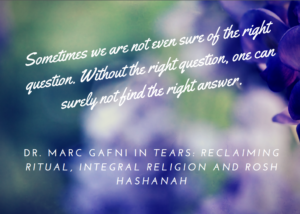God in the Second Person – Crisis of Finitude
 The daily prayer practice emerges in large part from a crisis in identity. Prayer seeks to answer, via experience, the question that Ramana Maharishi places at the center of spiritual work for his disciples: “Who Am I?” It is told that a certain Hassid came to Reb Hanoch of Alexander had great difficulty getting dressed in the morning before prayer for he could not find his clothing. So his question to his teacher was: “How might I get dressed in the morning?”
The daily prayer practice emerges in large part from a crisis in identity. Prayer seeks to answer, via experience, the question that Ramana Maharishi places at the center of spiritual work for his disciples: “Who Am I?” It is told that a certain Hassid came to Reb Hanoch of Alexander had great difficulty getting dressed in the morning before prayer for he could not find his clothing. So his question to his teacher was: “How might I get dressed in the morning?”
Sometimes we are not even sure of the right question. Without the right question, one can surely not find the right answer.
Reb Hanoch made a simple, yet wise suggestion. “Make a list of all of your articles of clothing along with a note of where you put them. Then, when you wake up in the morning, simply follow your list — item by item of clothing — and you will be properly dressed in no time.” This, the man did. And indeed, the very next morning he found himself successfully dressed without a hassle. But as he put on his last item of clothing, confusion once again set upon him. “But where am I? But where am I?” he exclaimed over and over, searching his home and rummaging through his closets and drawers.
And one imagines that the master R. Hanoch smiled, for his student has finally found the right question: “Where am I?”— the echo of God’s first question to First Human: “Indeed, where are you?” Or, in the modern discourse on identity, “Who am I?” is the ultimate question.
It is the question Moses asked in his prayer to God, as well as David. And it is a question that is answered in prayer.
From Tears: Reclaiming Ritual, Integral Religion and Rosh Hashanah by Dr. Marc Gafni
Here you can listen to the “Dance of Tears Lectures” that Marc held in 2003 to an overflowing hall of beautiful and holy people whose very receiving of this teaching, both cognitively, bodily and emotionally, made the teaching itself, deeper and more clear. The teaching was given at the Biennial Kallah of the Jewish Renewal movement.








